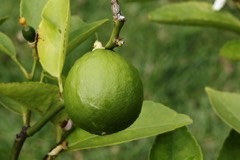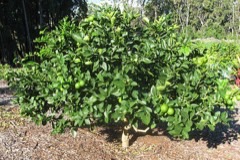 |
|
commons.wikimedia.org/wiki/User:PierreSelim |
 |
| Forest Starr and Kim Starr flickr.com/people/97499887@N06 |
Translate this page:
Summary
Physical Characteristics

 Citrus latifolia is an evergreen Tree growing to 5 m (16ft) by 5 m (16ft) at a medium rate.
Citrus latifolia is an evergreen Tree growing to 5 m (16ft) by 5 m (16ft) at a medium rate.
See above for USDA hardiness. It is hardy to UK zone 10. The flowers are pollinated by Insects.
It is noted for attracting wildlife.
Suitable for: light (sandy), medium (loamy) and heavy (clay) soils and prefers well-drained soil. Suitable pH: mildly acid and neutral soils. It can grow in semi-shade (light woodland). It prefers moist soil.
UK Hardiness Map
US Hardiness Map
Synonyms
C. x latifolia. C. x aurantiifolia var. latifolia Yu.Tanaka. C. x aurantiifolia subsp. latifolia (Yu.Tanaka) S.Ríos, D.Rivera & Obón .
Plant Habitats
Edible Uses
Edible Parts: Flowers Fruit Leaves Oil
Edible Uses: Condiment Drink Oil
If you only have room for one fruit tree, the Tahitian Lime would be our top choice. The seedless, juicy, thin-skinned fruit has a great flavour and an endless range of uses in the kitchen. The flesh is a translucent pale green, tender and juicy with an authentic acid lime flavour. The fruit is about 6 cm (2.4 in) in diameter, often with slightly nippled ends, and is usually sold while green, although it yellows as it reaches full ripeness. The fruits are used for making drinks [317 ]. The pulp is succulent, firm, very acidic and sugarless [317 ]. The juice is a substitute for vinegar [317 ]. It is also widely available dried, as it is often used this way in Persian cuisine. It is larger, thicker-skinned, with less intense citrus aromatics than Key Lime (Citrus aurantifolia). The advantages of the Tahitian Lime in commercial agriculture compared to the Key Lime are the larger size, absence of seeds, hardiness, lack of thorns on the bushes, and longer fruit shelf life. They are less acidic than key limes and do not have the bitterness of their unique flavour.
References More on Edible Uses
Medicinal Uses
Plants For A Future can not take any responsibility for any adverse effects from the use of plants. Always seek advice from a professional before using a plant medicinally.
Antidote Antiinflammatory Aromatherapy Skin Vitamin C
The juice of the fruit is utilized medicinally [317 ]. Lime juice, given quickly, is an effective antidote for the painful oral irritation and inflammation that result from biting into aroids such as Dieffenbachia spp., Xanthosoma spp., Philodendron spp., and their allies [336 ]. Lime juice is also applied to relieve the effects of stinging corals [336 ]. Citrus species contain a wide range of active ingredients, and research is still underway in finding uses for them. They are rich in vitamin C, flavonoids, acids and volatile oils. They also contain coumarins such as bergapten which sensitizes the skin to sunlight. Bergapten is sometimes added to tanning preparations since it promotes pigmentation in the skin, though it can cause dermatitis or allergic responses in some people [238 ]. Some of the plants more recent applications are as sources of anti-oxidants and chemical exfoliants in specialized cosmetics [238 ].
References More on Medicinal Uses
The Bookshop: Edible Plant Books
Our Latest books on Perennial Plants For Food Forests and Permaculture Gardens in paperback or digital formats.

Edible Tropical Plants
Food Forest Plants for Hotter Conditions: 250+ Plants For Tropical Food Forests & Permaculture Gardens.
More

Edible Temperate Plants
Plants for Your Food Forest: 500 Plants for Temperate Food Forests & Permaculture Gardens.
More

More Books
PFAF have eight books available in paperback and digital formats. Browse the shop for more information.
Shop Now
Other Uses
Cleanser Cosmetic Essential Hair Oil
Essential oil is extracted from the peel of the fruit [317 ]. Lime juice is employed as a rinse after shampooing the hair. Light streaks have been bleached in the hair by applying lime juice and then going out into the sun for a time [336 ]. Lime juice has been applied to the face as a freshening lotion [336 ]. The acid juice can be used for cleaning items such as the inside of coffee and teapots [336 ]. Dilute lime juice will dissolve, overnight, calcium deposits in kettles [336 ]. Attracts wildlife. Espalier: tree or other plant that is trained to grow flat against a support (such as a trellis or wall).
Special Uses
Attracts Wildlife Espalier Food Forest Scented Plants
References More on Other Uses
Cultivation details
The most widely cultivated lime species commercially. A citrus fruit species of hybrid origin; a triploid cross between Key Lime (Citrus _ aurantiifolia) and Lemon (Citrus limon). Three main climates are suitable for commercial citrus production - tropical climates, subtropical with winter rain in the Mediterranean and semitropical with summer rainfall as found in Florida and southern Brazil [200 ]. The optimal temperatures for citrus cultivation range between 25 - 30°c, with the coldest month having an average minimum of at least 15°c [200 ]. Growth generally ceases below 13°c and above 38°c [200 ]. It prefers a mean annual rainfall in the range 1,200 - 1,500mm, but tolerates 750 - 2,300mm [418 ]. If there are dry periods of more than three months, then irrigation will be necessary [200 ]. Limes prefer deep, well-drained but moisture-retentive loamy soil in full sun [200 ]. Prefers a pH in the range 5.5 - 6.5, tolerating 5 - 7.5 [200 , 418 ]. The plant flowers and fruits all year round but with a distinct fruiting peak towards the end of summer [336 ]. Yields of 41 kilos of fruit have been obtained from trees two metres tall [336 ]. Tahiti lime flowers have no viable pollen [336 ]. When grown on their own, they produce a usually seedless fruit; rarely, the fruit may contain one or a few seeds, especially if planted among several other Citrus species [336 ]. The tree is nearly thornless. Cultivars include Bearss lime, Page lime, Persian lime, Pond's lime, and Tahiti lime. Tolerate light frost. Trees are self-pollinated and suit backyards and orchards. They can be pruned to 2 metres high for use as a large container plant. A wide range of tree sizes is available depending on the rootstock, including dwarf varieties. The time to Fruit/Flower/Harvest is typically 4-5 Years. Pick the fruit green as it can suffer from rot if left to ripen on the tree. Espalier.
References Carbon Farming Information and Carbon Sequestration Information
Temperature Converter
Type a value in the Celsius field to convert the value to Fahrenheit:
Fahrenheit:
The PFAF Bookshop
Plants For A Future have a number of books available in paperback and digital form. Book titles include Edible Plants, Edible Perennials, Edible Trees,Edible Shrubs, Woodland Gardening, and Temperate Food Forest Plants. Our new book is Food Forest Plants For Hotter Conditions (Tropical and Sub-Tropical).
Shop Now
Plant Propagation
Seed. Usually grafted.
Other Names
If available other names are mentioned here
Citrus x latifolia, Tahiti Lime, Persian lime, Seedless lime, Bearss lime
Native Range
Asia, Australia, Brazil, French Polynesia, Hawaii, Mediterranean, India, Iran, Pacific, Portugal, South America, Tahiti, USA (inc. Florida, California), Venezuela [1-4].
Weed Potential
Right plant wrong place. We are currently updating this section.
Please note that a plant may be invasive in one area but may not in your area so it's worth checking.
None Known
Conservation Status
IUCN Red List of Threatened Plants Status : Not Listed.

| Related Plants
|
| Latin Name | Common Name | Habit | Height | Hardiness | Growth | Soil | Shade | Moisture | Edible | Medicinal | Other |
| Citrus aurantiifolia | Lime, Key Lime, Mexican Lime, Mexican Thornless Key Lime | Tree | 6.0 |
10-12
| M | LMH | N | M | 4 | 2 | 3 |
| Citrus aurantium | Bitter Orange, Sour orange, Bergamot orange | Tree | 9.0 |
8-11
| M | MH | N | M | 3 | 3 | 4 |
| Citrus hystrix | Kaffir Lime | Shrub | 6.0 |
9-12
| M | LMH | N | M | 3 | 2 | 3 |
| Citrus ichangensis | Ichang Papeda | Shrub | 4.5 |
7-10
| | LMH | N | M | 2 | 2 | |
| Citrus limon | Lemon | Shrub | 3.0 |
8-11
| M | MH | N | DM | 4 | 5 | 5 |
| Citrus medica | Citron | Shrub | 4.0 |
9-11
| M | LMH | N | DM | 3 | 2 | 3 |
| Citrus reticulata | Mandarin, Tangerine, Unshu orange, Satsuma Orange,Temple Orange, Tangerine | Tree | 4.5 |
9-11
| M | MH | N | M | 3 | 3 | 2 |
| Citrus sinensis | Sweet Orange | Tree | 9.0 |
9-11
| M | MH | N | M | 4 | 3 | 3 |
| Citrus x junos | Yuzu | Tree | 4.0 |
8-10
| M | LMH | SN | M | 3 | 1 | 3 |
| Citrus x meyeri | Lemon | Shrub | 3.0 |
8-11
| M | MH | N | M | 3 | 5 | 5 |
| Citrus x paradisi | Grapefruit, Pomelo, Pamplemousse | Tree | 7.0 |
9-11
| M | LMH | N | DM | 4 | 1 | 2 |
|
Growth: S = slow M = medium F = fast. Soil: L = light (sandy) M = medium H = heavy (clay). pH: A = acid N = neutral B = basic (alkaline). Shade: F = full shade S = semi-shade N = no shade. Moisture: D = dry M = Moist We = wet Wa = water.
Now available:
Food Forest Plants for Mediterranean Conditions
350+ Perennial Plants For Mediterranean and Drier Food Forests and Permaculture Gardens.
[Paperback and eBook]
This is the third in Plants For A Future's series of plant guides for food forests tailored to
specific climate zones. Following volumes on temperate and tropical ecosystems, this book focuses
on species suited to Mediterranean conditions—regions with hot, dry summers and cool, wet winters,
often facing the added challenge of climate change.
Read More
Expert comment
Author
(Yu.Tanaka) Yu.Tanaka
Botanical References
Links / References
For a list of references used on this page please go here
A special thanks to Ken Fern for some of the information used on this page.
Readers comment
| Add a comment |
|
If you have important information about this plant that may help other users please add a comment or link below. Only comments or links that are felt to be directly relevant to a plant will be included. If you think a comment/link or information contained on this page is inaccurate or misleading we would welcome your feedback at [email protected]. If you have questions about a plant please use the Forum on this website as we do not have the resources to answer questions ourselves.
* Please note: the comments by website users are not necessarily those held by PFAF and may give misleading or inaccurate information.
To leave a comment please Register or login here All comments need to be approved so will not appear immediately.
|
Subject : Citrus latifolia
|
|
|
|